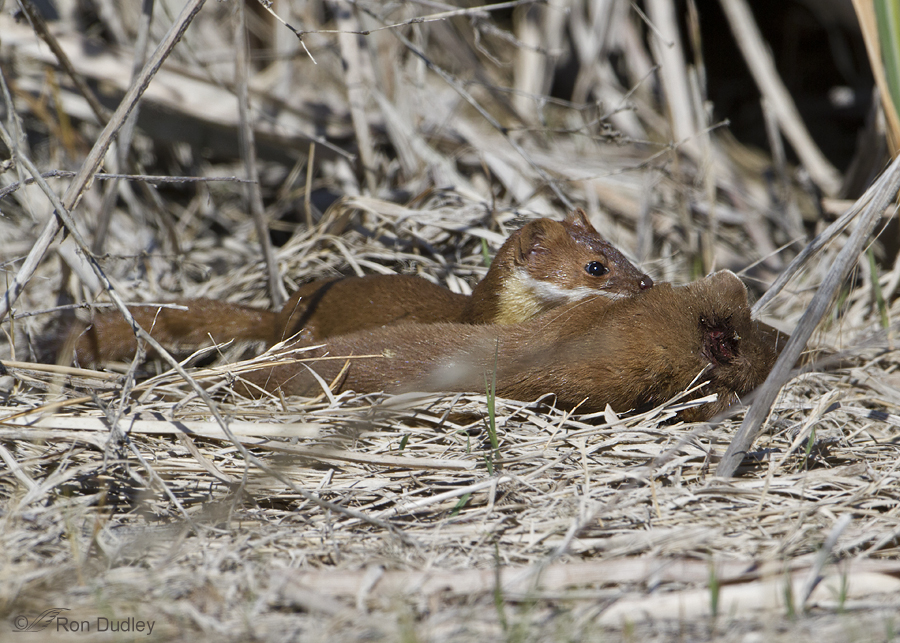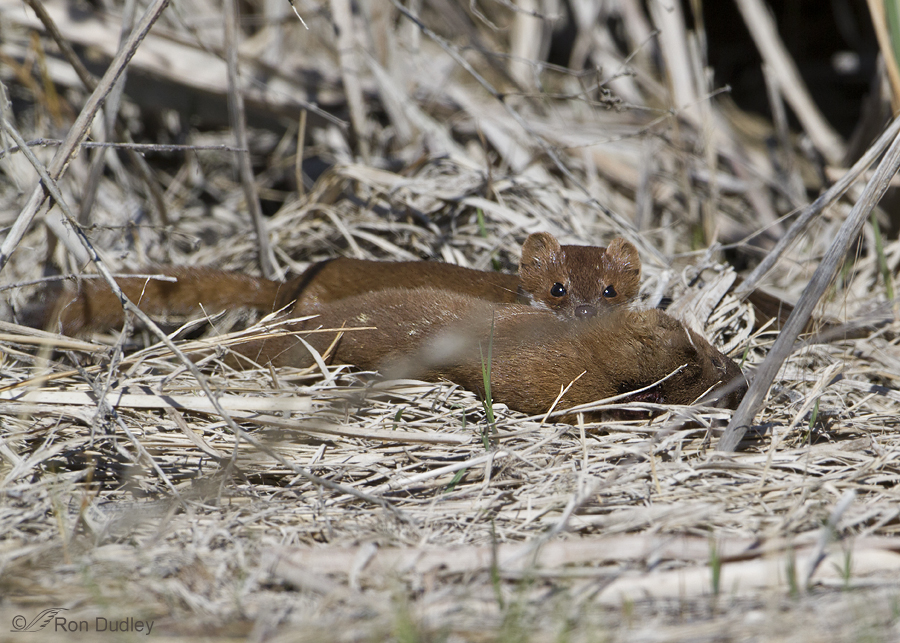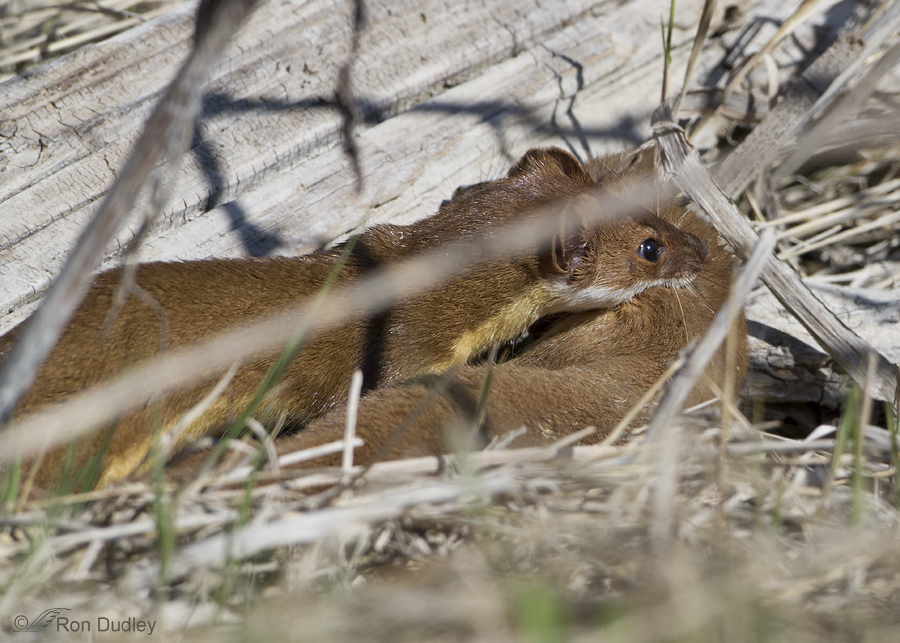Long-tailed Weasels are elusive and fascinating critters. Some interesting information about them might include the following:
- sexually dimorphic, females 10 to 15% smaller than males
- the name is appropriate as the length of their tail can equal up to 70% of the head and body length
- eyes are black in daylight but glow a bright, emerald-green in a spotlight at night
- like other mustelids, have anal scent glands that produce a liquid with a strong, musky odor
- go through delayed implantation, they mate in July-Aug but implantation (and growth) of fertilized egg into uterine wall is delayed until March but after implantation the embryo develops for only 4 weeks before birth. This timing allows for birth in spring when prey is abundant.
- are obligate carnivores, prefer prey fresh or alive, seldom eat carrion
- aggressive and fearless hunters, often killing prey much larger than themselves with a bite to the neck
- favorite prey includes mice, rats, chipmunks, squirrels, moles, shrews, rabbits and chickens
- are “surplus killers”, often killing more than they can consume
And they are occasional cannibals!
Previously I posted two images from this encounter with a cannibalistic weasel at Bear River Migratory Bird Refuge. These three photos are new to my blog.

This weasel had killed one of its kin and was trying to run with the body along the road at the refuge. It was having a very difficult time carrying that long corpse through all the vegetation, which was probably the only thing that slowed it down enough for me to manage a few photos.

One time it stopped momentarily to rest and stared intensely at me with those penetrating, beady eyes.

It was virtually impossible to get unobstructed views and good focus through all the vegetation but I thought this shot well illustrated the grasp the weasel had on the throat of the other weasel.
I’m primarily a bird photographer so I find it ironic that my number one “nemesis species” doesn’t have feathers – the Long-tailed Weasel. I’m constantly on the lookout for them but I’ve only had a few opportunities with them in the last 7 years of photography. Hopefully that pathetic track record will soon improve.
Ron
Note: A comment on a later weasel post by Master Falconer Mark Runnels brings into question my assertion that some of the photos here were related to cannibalism. Marks fascinating comment is below:
I don’t know anything about weasels, but we keep their close relative, ferrets, to hunt with our Harris’ hawks. If the rabbit goes into a hole in the ground, or more commonly, into a piece of oilfield pipe, we can send the ferret down to get it moving again.
Several years ago, when I was in college (yikes! that was 25 years ago!) I decided that I wanted to breed my jill (female) and raise a litter of kits. The owner of the male tried to warn me not to watch, but I was interested in anything related to ferret biology, so I stuck around. Ferret breeding is a violent business! The much larger hob (male) male grabbed my jill by the scruff of the neck neck and beat her head against the hardwood floor, furniture, or any other hard surface he could find. This continued for several minutes until she was completely unconscious after which time he drug her limp body around the room for several minutes before finding a quiet corner and copulating with her several times. Once she regained consciousness, the two carried on as though nothing unusual had happened. I am not usually squeamish, but I could never again breed one of my jills and started having them spayed. Natural or not, I didn’t have the stomach to watch that again! I have since learned that this behavior is normal and is typical of minks as well, but not skunks.
Why am I sharing this disturbing behavior with you? I got to wondering it the cannibalistic weasel in your earlier post had really killed one of its kin and was carrying it off to be eaten, or is it possible that the breeding habits of the weasel are similar to the ferret and this was a male that had knocked out a female and was dragging her off to breed with the unconscious body in a quiet location somewhere?
As I said, I know nothing about weasel biology, but it is an interesting question.
Thanks for the great pictures.
Mark


Disturbing, but interesting…can’t help but wonder what the whole story is. There no doubt is some justification for what’s happening here, more so than with the far taller,far more destructive two-legged killers.
As to the cannibalism comment. I suppose dragging the carcas off implies that the carcas would be consumed but without observing such we can only infer.
What fascinating behavior you documented!
I suspect that you could post photographs of your garbage and the calibre of the photo and the commentary would make for an interesting post. However, I have really enjoyed your excursions into non-avian photography and am more than happy to see them. Essentially – thank you for sharing. I suspect that cannabalism, like homosexual behaviour in animals fell for a long time into a ‘no-go’ area so that little research was done, and less published. It is really quite amazing how many living things share this planet with us that we know very little about.
Ron – your site and photography is thrilling to me and adds to my life. That you share your photography is incredibly generous. I read your post on the ‘stealing’ of photos. I am naive to the consequences and my question is, if I used your photo to show what a long-tailed weasel look like, innocently, on Facebook…I credited your amazing photography, but was this wrong? I will not do it again, and I feel quilty, but hopefully didn’t cross the line of ‘stealing’ and certainly didn’t mean to ….you just happen to have about the best, cutest photo of the winter morph of the weasel standing, and I skiied upon one, and wanted to share. So, I am looking for your answer that you do not want your photos shared on social media. Sorry I am blurry on that. Because you add to my birding life soo strongly! Not to mention if I ever approached photography…thank you for all your talented work. Molly
Hi Molly,
Thank you for posting this somewhat delicate question on an open forum. I’ll bet it wasn’t easy to do and I applaud you for it…
The short answer is yes, I would prefer that my images aren’t posted anywhere on the net, including social media, without my permission. Most serious photographers feel the same. That’s what’s right, and what’s legal. If folks want to post my images, or those of any other photographer, they should post the links to the site (galleries, blogs, whatever) instead of copying and then posting.
That said, I’m fully aware that much of what is done on social sites is done innocently enough, as in your case. Too many folks just don’t understand all the implications and there are many (too many to go into here). And dealing with it becomes a ticklish situation on our end. One example of many:
When I file a DMCA takedown notice with some of these social media sites I have the option of having all copies of that image on the site removed, which I do – which means I don’t know all of the people I’m filing the take-down notice on (many of them are shared multiple times, Pinterest for example). Some of them may be folks I know, or who comment regularly on my blog. Recently that happened. One person sent me an indignant email, asking why I didn’t ask him/her personally to take it down rather than do it through the site, which is a strike against them (more such notices may mean they lose their priveleges). After this person and I sorted it out all was well between us but it’s a very awkward and delicate situation…
Once again Molly, I appreciate you asking the question here. A lot.
Ron
Although you claim to be “primarily a bird photographer,” you sure did a great job with these beautiful little animals. The name of your blog notwithstanding, may I humbly request that you NOT avoid posting your shots of non-avian wildlife? I have really enjoyed yours past photos of coyotes and others.
Thank you once again for the encouragement, Dwynn. No, I won’t avoid posting non-avian wildlife – it’s just that my primary quarry has feathers but that puts me in a position to see some interesting mammalian stuff too. And I always have three cameras and three lenses with me to adapt to the situation so yes, there’ll be more coming down the road.
I wonder if the reason the Long -tail weasel’s aggressive nature is due to territorial issues.Then in turn ( not to waste a meal ) becomes cannibalistic. I’ve heard of sibling rivalry ,but yipes !
Thanks Ron ! Hope you more opportunities to photograph this amazing weasel.
John, I’ve been doing some research on animal cannibalism. Extremely interesting stuff. Cannibalism is much more common, across a wide variety of species, than most “experts” suspected. And the reasons the behavior was selected for are not well understood.
Great photos and post, Ron. Very informative. Very good job of getting the eyes in focus.
Thanks, Bob. It wasn’t easy getting focus through all of that “stuff”.